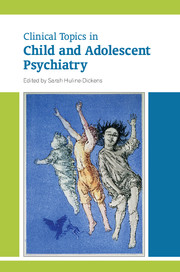Book contents
- Frontmatter
- Contents
- List of tables
- List of boxes
- List of figures
- List of contributors
- Preface
- 1 Child psychiatry and the people who have shaped it
- 2 Fabrication and induction of illness in children
- 3 Personality disorders as disorganisation of attachment and affect regulation
- 4 Post-traumatic stress disorder and attachment: possible links with borderline personality disorder
- 5 Management of antisocial behaviour in childhood
- 6 Pharmacology for attention-deficit hyperactivity disorder, Tourette syndrome and autism spectrum disorder
- 7 Pharmacology for anxiety and obsessive–compulsive disorders, affective disorders and schizophrenia
- 8 Pharmacological management of core and comorbid symptoms in autism spectrum disorder
- 9 Pharmacological treatment of depression and bipolar disorder
- 10 Cognitive–behavioural therapy with children, young people and families: from individual to systemic therapy
- 11 Anxiety disorders
- 12 Somatising: clinical presentations and aetiological factors
- 13 Somatising: management and outcomes
- 14 Evaluating psychological treatments for children with autism
- 15 Attention-deficit hyperactivity disorder: assessment and treatment
- 16 Schizophrenia
- 17 Tourette syndrome
- 18 Sleep disorders
- 19 Self-harm in adolescents
- 20 Adolescent substance misuse: an update on behaviours and treatments
- 21 Eating disorders
- 22 Gender dysphoria in young people
- 23 The psychiatry of children aged 0–4
- Index
Preface
Published online by Cambridge University Press: 02 January 2018
- Frontmatter
- Contents
- List of tables
- List of boxes
- List of figures
- List of contributors
- Preface
- 1 Child psychiatry and the people who have shaped it
- 2 Fabrication and induction of illness in children
- 3 Personality disorders as disorganisation of attachment and affect regulation
- 4 Post-traumatic stress disorder and attachment: possible links with borderline personality disorder
- 5 Management of antisocial behaviour in childhood
- 6 Pharmacology for attention-deficit hyperactivity disorder, Tourette syndrome and autism spectrum disorder
- 7 Pharmacology for anxiety and obsessive–compulsive disorders, affective disorders and schizophrenia
- 8 Pharmacological management of core and comorbid symptoms in autism spectrum disorder
- 9 Pharmacological treatment of depression and bipolar disorder
- 10 Cognitive–behavioural therapy with children, young people and families: from individual to systemic therapy
- 11 Anxiety disorders
- 12 Somatising: clinical presentations and aetiological factors
- 13 Somatising: management and outcomes
- 14 Evaluating psychological treatments for children with autism
- 15 Attention-deficit hyperactivity disorder: assessment and treatment
- 16 Schizophrenia
- 17 Tourette syndrome
- 18 Sleep disorders
- 19 Self-harm in adolescents
- 20 Adolescent substance misuse: an update on behaviours and treatments
- 21 Eating disorders
- 22 Gender dysphoria in young people
- 23 The psychiatry of children aged 0–4
- Index
Summary
Caught up in the drama and conflict of other people's lives, children are often to be found in Paula Rego's art in those sinister, paradoxical or unexpected ways familiar to child psychiatrists. Sometimes they are looking after parents, sometimes they are about to be abused or humiliated, and sometimes they are even performing their own abortions. Her image on the cover of this book features J. M. Barrie's character Peter Pan, or The Boy Who Wouldn't Grow Up. Though apparently playful and mischievous, Peter Pan is in flight, and his escape from parents and family is a means of coping with painful displacement, or something worse.
As described in the introduction to this book (Chapter 1), there has always been a hope that a study of troubled children would produce recorded information of how mental illness began (Evans et al, 2008: p. 456) (my italics). This aim is an important one, and one that often attracts child psychiatrists to the work in the first place. Unfortunately, for many clinicians it is so often forgotten in the business of endless restructuring of service provision and policy revision.
However much policy material is produced, the real function of most child psychiatrists is to assess and treat mental disorders in childhood and adolescence. This book is aimed at them, to help them keep up to date with clinical topics. The clinical topic can be seen to reflect the medical approach to a clinical problem and embody a certain habit of thought, often involving the application of clinical reasoning and diagnostic decision-making. Most chapters in this book concern discrete clinical disorders, although some are about an aspect of treatment, such as pharmacological management. All are central to the work of practising clinicians in the specialty, and many will be relevant to other doctors, psychologists, child and adolescent mental health professionals, social workers, teachers and students, and trainees in all of these fields.
The selection of topics has largely been guided by what has appeared in the journal Advances of Psychiatric Treatment in the form of educational articles published since 1994. These chapters therefore represent a scholarly trend of practice over the past two decades.
- Type
- Chapter
- Information
- Clinical Topics in Child and Adolescent Psychiatry , pp. xvii - xxiiPublisher: Royal College of PsychiatristsPrint publication year: 2014

